François Goulette
CAOR
Is Semantic SLAM Ready for Embedded Systems ? A Comparative Survey
May 18, 2025Abstract:In embedded systems, robots must perceive and interpret their environment efficiently to operate reliably in real-world conditions. Visual Semantic SLAM (Simultaneous Localization and Mapping) enhances standard SLAM by incorporating semantic information into the map, enabling more informed decision-making. However, implementing such systems on resource-limited hardware involves trade-offs between accuracy, computing efficiency, and power usage. This paper provides a comparative review of recent Semantic Visual SLAM methods with a focus on their applicability to embedded platforms. We analyze three main types of architectures - Geometric SLAM, Neural Radiance Fields (NeRF), and 3D Gaussian Splatting - and evaluate their performance on constrained hardware, specifically the NVIDIA Jetson AGX Orin. We compare their accuracy, segmentation quality, memory usage, and energy consumption. Our results show that methods based on NeRF and Gaussian Splatting achieve high semantic detail but demand substantial computing resources, limiting their use on embedded devices. In contrast, Semantic Geometric SLAM offers a more practical balance between computational cost and accuracy. The review highlights a need for SLAM algorithms that are better adapted to embedded environments, and it discusses key directions for improving their efficiency through algorithm-hardware co-design.
Leg Exoskeleton Odometry using a Limited FOV Depth Sensor
Feb 26, 2025Abstract:For leg exoskeletons to operate effectively in real-world environments, they must be able to perceive and understand the terrain around them. However, unlike other legged robots, exoskeletons face specific constraints on where depth sensors can be mounted due to the presence of a human user. These constraints lead to a limited Field Of View (FOV) and greater sensor motion, making odometry particularly challenging. To address this, we propose a novel odometry algorithm that integrates proprioceptive data from the exoskeleton with point clouds from a depth camera to produce accurate elevation maps despite these limitations. Our method builds on an extended Kalman filter (EKF) to fuse kinematic and inertial measurements, while incorporating a tailored iterative closest point (ICP) algorithm to register new point clouds with the elevation map. Experimental validation with a leg exoskeleton demonstrates that our approach reduces drift and enhances the quality of elevation maps compared to a purely proprioceptive baseline, while also outperforming a more traditional point cloud map-based variant.
3DLabelProp: Geometric-Driven Domain Generalization for LiDAR Semantic Segmentation in Autonomous Driving
Jan 24, 2025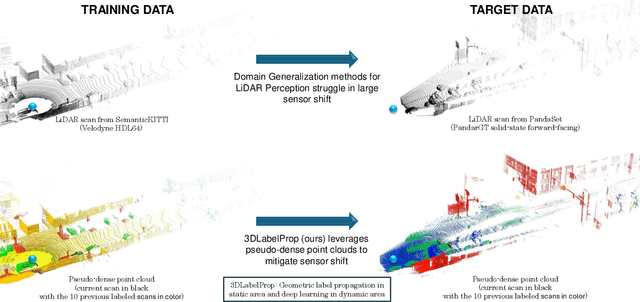

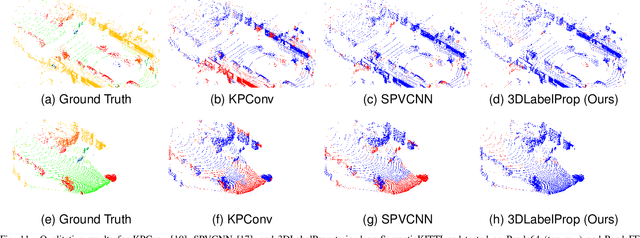

Abstract:Domain generalization aims to find ways for deep learning models to maintain their performance despite significant domain shifts between training and inference datasets. This is particularly important for models that need to be robust or are costly to train. LiDAR perception in autonomous driving is impacted by both of these concerns, leading to the emergence of various approaches. This work addresses the challenge by proposing a geometry-based approach, leveraging the sequential structure of LiDAR sensors, which sets it apart from the learning-based methods commonly found in the literature. The proposed method, called 3DLabelProp, is applied on the task of LiDAR Semantic Segmentation (LSS). Through extensive experimentation on seven datasets, it is demonstrated to be a state-of-the-art approach, outperforming both naive and other domain generalization methods.
Open-Set 3D object detection in LiDAR data as an Out-of-Distribution problem
Oct 31, 2024Abstract:3D Object Detection from LiDAR data has achieved industry-ready performance in controlled environments through advanced deep learning methods. However, these neural network models are limited by a finite set of inlier object categories. Our work redefines the open-set 3D Object Detection problem in LiDAR data as an Out-Of-Distribution (OOD) problem to detect outlier objects. This approach brings additional information in comparison with traditional object detection. We establish a comparative benchmark and show that two-stage OOD methods, notably autolabelling, show promising results for 3D OOD Object Detection. Our contributions include setting a rigorous evaluation protocol by examining the evaluation of hyperparameters and evaluating strategies for generating additional data to train an OOD-aware 3D object detector. This comprehensive analysis is essential for developing robust 3D object detection systems that can perform reliably in diverse and unpredictable real-world scenarios.
COLA: COarse-LAbel multi-source LiDAR semantic segmentation for autonomous driving
Nov 06, 2023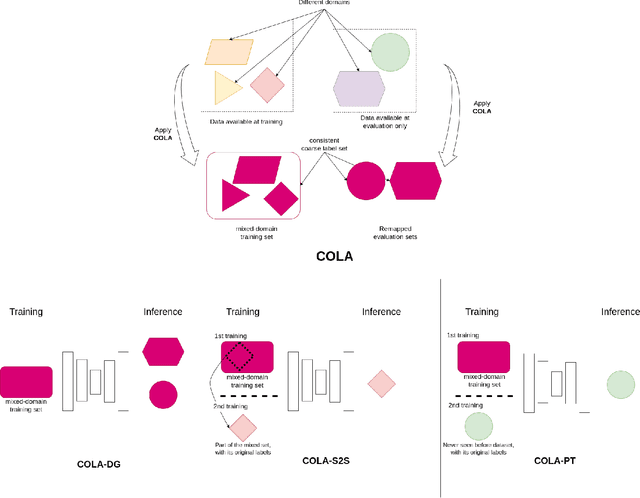

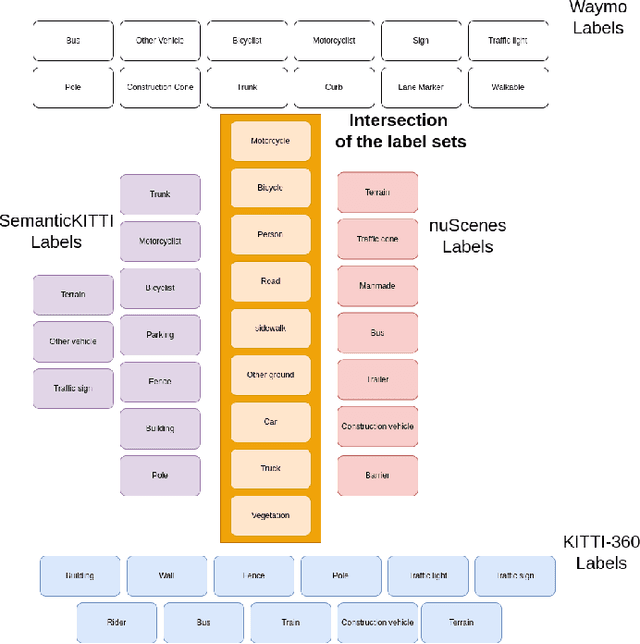

Abstract:LiDAR semantic segmentation for autonomous driving has been a growing field of interest in the past few years. Datasets and methods have appeared and expanded very quickly, but methods have not been updated to exploit this new availability of data and continue to rely on the same classical datasets. Different ways of performing LIDAR semantic segmentation training and inference can be divided into several subfields, which include the following: domain generalization, the ability to segment data coming from unseen domains ; source-to-source segmentation, the ability to segment data coming from the training domain; and pre-training, the ability to create re-usable geometric primitives. In this work, we aim to improve results in all of these subfields with the novel approach of multi-source training. Multi-source training relies on the availability of various datasets at training time and uses them together rather than relying on only one dataset. To overcome the common obstacles found for multi-source training, we introduce the coarse labels and call the newly created multi-source dataset COLA. We propose three applications of this new dataset that display systematic improvement over single-source strategies: COLA-DG for domain generalization (up to +10%), COLA-S2S for source-to-source segmentation (up to +5.3%), and COLA-PT for pre-training (up to +12%).
MDT3D: Multi-Dataset Training for LiDAR 3D Object Detection Generalization
Aug 02, 2023Abstract:Supervised 3D Object Detection models have been displaying increasingly better performance in single-domain cases where the training data comes from the same environment and sensor as the testing data. However, in real-world scenarios data from the target domain may not be available for finetuning or for domain adaptation methods. Indeed, 3D object detection models trained on a source dataset with a specific point distribution have shown difficulties in generalizing to unseen datasets. Therefore, we decided to leverage the information available from several annotated source datasets with our Multi-Dataset Training for 3D Object Detection (MDT3D) method to increase the robustness of 3D object detection models when tested in a new environment with a different sensor configuration. To tackle the labelling gap between datasets, we used a new label mapping based on coarse labels. Furthermore, we show how we managed the mix of datasets during training and finally introduce a new cross-dataset augmentation method: cross-dataset object injection. We demonstrate that this training paradigm shows improvements for different types of 3D object detection models. The source code and additional results for this research project will be publicly available on GitHub for interested parties to access and utilize: https://github.com/LouisSF/MDT3D
Multi-IMU Proprioceptive State Estimator for Humanoid Robots
Jul 26, 2023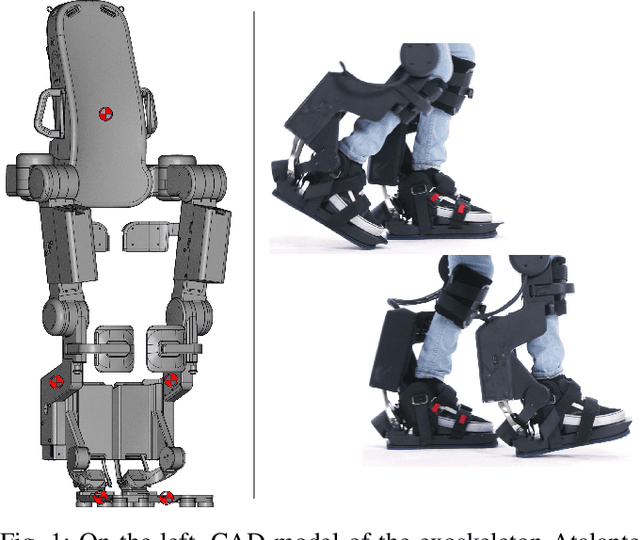
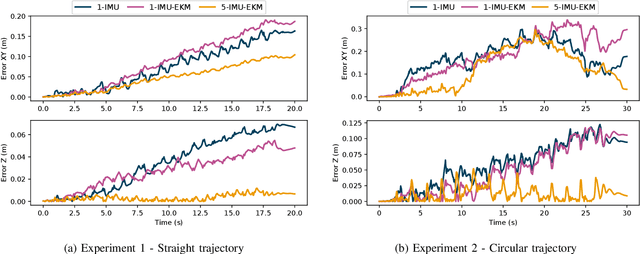


Abstract:Algorithms for state estimation of humanoid robots usually assume that the feet remain flat and in a constant position while in contact with the ground. However, this hypothesis is easily violated while walking, especially for human-like gaits with heel-toe motion. This reduces the time during which the contact assumption can be used, or requires higher variances to account for errors. In this paper, we present a novel state estimator based on the extended Kalman filter that can properly handle any contact configuration. We consider multiple inertial measurement units (IMUs) distributed throughout the robot's structure, including on both feet, which are used to track multiple bodies of the robot. This multi-IMU instrumentation setup also has the advantage of allowing the deformations in the robot's structure to be estimated, improving the kinematic model used in the filter. The proposed approach is validated experimentally on the exoskeleton Atalante and is shown to present low drift, performing better than similar single-IMU filters. The obtained trajectory estimates are accurate enough to construct elevation maps that have little distortion with respect to the ground truth.
UWED: Unsigned Distance Field for Accurate 3D Scene Representation and Completion
Mar 17, 2022



Abstract:Scene Completion is the task of completing missing geometry from a partial scan of a scene. The majority of previous methods compute an implicit representation from range data using a Truncated Signed Distance Function (TSDF) on a 3D grid as input to neural networks. The truncation limits but does not remove the ambiguous cases introduced by the sign for non-closed surfaces. As an alternative, we present an Unsigned Distance Function (UDF) called Unsigned Weighted Euclidean Distance (UWED) as input to the scene completion neural networks. UWED is simple and efficient as a surface representation, and can be computed on any noisy point cloud without normals. To obtain the explicit geometry, we present a method for extracting a point cloud from discretized UDF values on a regular grid. We compare different SDFs and UDFs for the scene completion task on indoor and outdoor point clouds collected from RGB-D and LiDAR sensors and show improved completion using the proposed UWED function.
AdaSplats: Adaptative Splats from Semantic Point Cloud for Fast and High-Fidelity LiDAR Simulation
Mar 17, 2022


Abstract:LiDAR sensors provide rich 3D information about surrounding scenes and are becoming increasingly important for autonomous vehicles' tasks, such as semantic segmentation, object detection, and tracking. Being able to simulate a LiDAR sensor will accelerate the testing, validation, and deployment of autonomous vehicles while reducing the cost and eliminating the risks of testing in real-world scenarios. To tackle the issue of simulating LiDAR data with high fidelity, we present a pipeline that leverages real-world point clouds acquired by mobile mapping systems. Point-based geometry representations, more specifically splats, have proven their ability to accurately model the underlying surface in very large point clouds. Showing the limits of basic splatting, we introduce an adaptative splats generation method that accurately models the underlying 3D geometry, especially for thin structures. We have also developed a LiDAR simulation that is 200 times faster-than-real-time by ray casting on GPU while focusing on efficiently handling large point clouds. We test our LiDAR simulation in real-world conditions, showing qualitative and quantitative results against basic splatting and meshing, demonstrating the superiority of our modeling technique.
COLA: COarse LAbel pre-training for 3D semantic segmentation of sparse LiDAR datasets
Feb 14, 2022



Abstract:Transfer learning is a proven technique in 2D computer vision to leverage the large amount of data available and achieve high performance with datasets limited in size due to the cost of acquisition or annotation. In 3D, annotation is known to be a costly task; nevertheless, transfer learning methods have only recently been investigated. Unsupervised pre-training has been heavily favored as no very large annotated dataset are available. In this work, we tackle the case of real-time 3D semantic segmentation of sparse outdoor LiDAR scans. Such datasets have been on the rise, but with different label sets even for the same task. In this work, we propose here an intermediate-level label set called the coarse labels, which allows all the data available to be leveraged without any manual labelization. This way, we have access to a larger dataset, alongside a simpler task of semantic segmentation. With it, we introduce a new pre-training task: the coarse label pre-training, also called COLA. We thoroughly analyze the impact of COLA on various datasets and architectures and show that it yields a noticeable performance improvement, especially when the finetuning task has access only to a small dataset.
 Add to Chrome
Add to Chrome Add to Firefox
Add to Firefox Add to Edge
Add to Edge